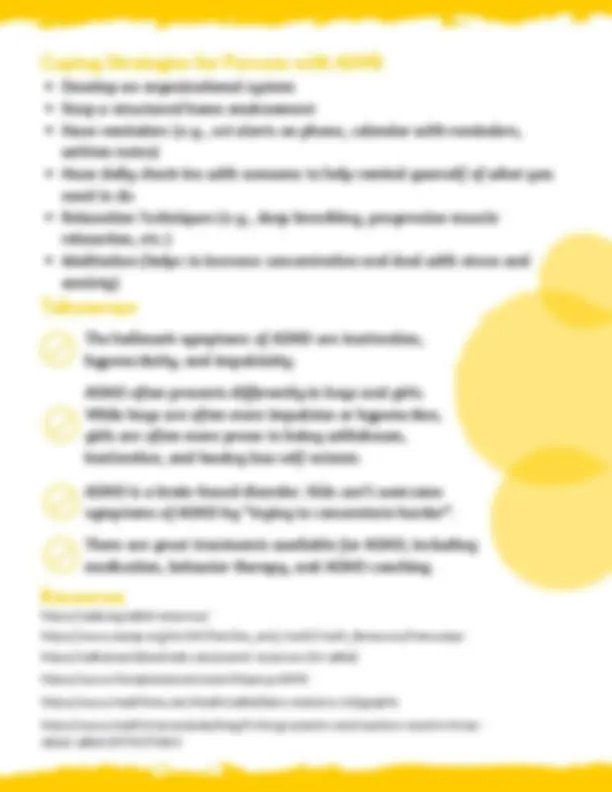



Study with the several resources on Docsity

Earn points by helping other students or get them with a premium plan


Prepare for your exams
Study with the several resources on Docsity

Earn points to download
Earn points by helping other students or get them with a premium plan
Community
Ask the community for help and clear up your study doubts
Discover the best universities in your country according to Docsity users
Free resources
Download our free guides on studying techniques, anxiety management strategies, and thesis advice from Docsity tutors
What is ADHD? ADHD stands for attention deficit hyperactivity disorder. It is a medical condition. A person with ADHD has differences in brain.
Typology: Summaries
1 / 2

This page cannot be seen from the preview
Don't miss anything!


How it affects your child and how you can help
MENTAL HEALTH INFO FOR PARENTS:
What is ADHD? ADHD stands for attention deficit hyperactivity disorder. It is a medical condition. A person with ADHD has differences in brain development and brain activity that affect attention, the ability to sit still, and self-control. ADHD can affect a child at school, at home, and in friendships. A person with ADHD may have symptoms related to inattention, hyperactivity, or BOTH. Common Symptoms Distractibility Difficulty concentrating Excessive talking Can’t sit still for long periods of time Appears to have more energy than is typical Difficulty planning Impulsivity Symptoms occur in more than one setting
Stats
of U.S. children are being treated for ADHD
increase in ADHD diagnoses over the past 8 years
age when ADHD symptoms typically first appear males are three times more likely to have ADHD than females
Coping Strategies for Persons with ADHD Develop an organizational system Keep a structured home environment Have reminders (e.g., set alerts on phone, calendar with reminders, written notes) Have daily check-ins with someone to help remind yourself of what you need to do Relaxation Techniques (e.g., deep breathing, progressive muscle relaxation, etc.) Meditation (helps to increase concentration and deal with stress and anxiety)
Resources
The hallmark symptoms of ADHD are inattention, hyperactivity, and impulsivity.
https://add.org/adhd-resources/
Takeaways
ADHD often presents differently in boys and girls. While boys are often more impulsive or hyperactive, girls are often more prone to being withdrawn, inattentive, and having low self-esteem.
ADHD is a brain-based disorder. Kids can’t overcome symptoms of ADHD by “trying to concentrate harder”. There are great treatments available for ADHD, including medication, behavior therapy, and ADHD coaching.
https://www.aacap.org/AACAP/Families_and_Youth/Youth_Resources/Home.aspx https://adhd.newlifeoutlook.com/parent-resources-for-adhd/ https://www.therapistaid.com/search?query=ADHD https://www.healthline.com/health/adhd/facts-statistics-infographic https://www.health.harvard.edu/blog/5-things-parents-and-teachers-need-to-know- about-adhd-